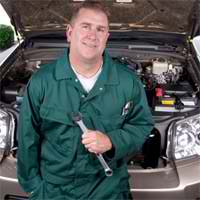New Insights Into Mesothelioma Risk Among Brake Mechanics
 The risk of mesothelioma among automobile brake mechanics may be higher than many in the industry even realize due, in part, to flawed research.
The risk of mesothelioma among automobile brake mechanics may be higher than many in the industry even realize due, in part, to flawed research.
A pair of researchers from Harvard and Brown Universities allege that a 2007 report deliberately manipulated asbestos exposure data to cast doubt about the relationship between malignant mesothelioma and brake work.
The report in question, an Australian study published in the journal Occupational Medicine, was commissioned and paid for by Daimler Chrysler Corporation, Ford Motor Company, and General Motors Corporation. It found the risk of mesothelioma among brake workers to be extremely low.
But the Massachusetts researchers say the former study results are unreliable because of how the different groups of brake mechanics were classified. According to the new study, when the data is reclassified in an unbiased way, the risk of mesothelioma among mechanics is clear.
Brake Mechanics and Mesothelioma Risk
Asbestos is the primary cause of mesothelioma worldwide. It has also been a component in car manufacturing for many years because of its strength and resistance to heat. It is most often found in brake drums and clutches.
When mechanics remove worn brakes to clean the brake drum, asbestos dust can come from the debris of the deteriorating pads. Asbestos dust is also created during the grinding and beveling of new brakes or clutch gaskets during installation.
Inhalation of asbestos fibers has been shown to cause a range of health problems of which pleural mesothelioma, a cancer of the lining around the lungs, and peritoneal mesothelioma, a cancer of the lining around the abdomen, are the most serious.
Compounding the risk for auto mechanics is the fact that they are often performing brake repair or replacement in a tight space where the dust is likely to be concentrated. Many wear no protective equipment.
To help counter the mesothelioma risk among US auto mechanics, the Environmental Protection Agency (EPA) and the Occupational Safety and Health Administration (OSHA) recommend that mechanics wear negative pressure respirators and use vacuums fitted with HEPA filters when working with brakes.
Reanalyzing Mesothelioma Statistical Data
The auto industry-sponsored study consisted of data from the Australian Mesothelioma Surveillance Registry (AMSR), a major source of information on mesothelioma rates in Australia.
In their re-evaluation of the AMSR data entitled “Corporate Corruption of Science – Another Asbestos Example” and published in the American Journal of Industrial Medicine, the Massachusetts researchers found that, out of 78 brake-related folios, 41 involved cases of people who “had no other asbestos exposure besides brake work or repair.”
“Asbestos mining and product manufacturing companies have manipulated medical literature to avoid paying compensation to injured workers for over 80 years,” write authors David Egilman, MD, and Ruben Monarrez, BA. “This company-sponsored research was not designed to protect worker health but rather to defend automobile manufacturing companies in litigation.”
In addition to malignant mesothelioma, asbestos exposure has also been associated with lung cancer, asbestosis, and development of pleural plaques.
Source:
Egilman and Monarre, “Corporate Corruption of Science–Another Asbestos Example”, January 12, 2017, American Journal of Industrial Medicine, Epub ahead of print





